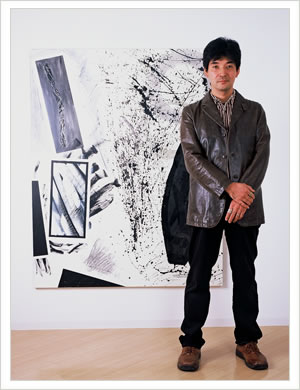
日本語 / English

1988Tokyo University of the Arts, Tokyo, BA in Oil Painting
1990Tokyo University of the Arts, Tokyo, MA in Oil Painting
1993Tokyo University of the Arts, Tokyo, Ph.D. in Painting
Thesis (no.34): Studies of Abstract Painting in the Relationship between “figure” and “ground.”
Solo Exhibitions
1987Gallery Akiyama, Tokyo, Japan
1988Gallery Space Adesso, Hyogo, Japan
1994Gallery of Tokyo University of the Arts, Tokyo, Japan
1998,99,00,01,02,03,05,06Gallery Seira, Tokyo, Japan
2007,08,09,10,11,12,13,14Gallery Miyasaka, Tokyo, Japan
2007,09,11,13,14O Gallery, Tokyo, Japan
2009O Gallery, Tokyo, Japan
2012Sagamihara Citizen’s Gallery Art Spot Gallery Staff Selection #42
“Tetsuo Koya, Classical Abstractionism -To the New Pictorial Space-”
Selected Group Exhibitions, Competitions, etc.
1985“Two-Person Exhibition,” Gallery Parergon Ⅱ, Tokyo, Japan
1985,86“Two-Person Exhibition,” Gallery of Tokyo University of the Arts, Tokyo, Japan
1987“Gen-Fukei (Original Scenery) 3,” Tokyo Metropolitan Art Museum, Tokyo, Japan
1996“Requiem-Koji Enokura and 33 Artists-,” Saito Memorial Kawaguchi
Museum of Contemporary Art, Saitama, Japan
1997“The 15th Art Award Show of the Ueno Royal Museum,” The Ueno Royal, Museum, Tokyo, Japan
2001“Drawing Ⅱ,” Gallery 52, Tokyo, Japan
2001,04“Two-Person Exhibition: Taiji-suru Uchukan (A Pair of Face to Face Views of the Universe),” Gallery Seira, Tokyo, Japan
2004,05,06,07,08,09,10,11“Exhibition of Sagamihara Artist Association,” , Sagamihara Citizen’s Gallery, Kanagawa, Japan
2007“Petit SOL #2,” Gallery SOL, Tokyo, Japan
2008Exhibition Collaborated with Kayoko Ohashi Clarinet Recital, Tokyo Bunka
Kaikan Recital Hall, Tokyo, Japan
“Sho: Paintings Express the Aura,” Gallery Inoue, Tokyo, Japan
“Two-Person Exhibition: Taiji-suru Uchukan (A Pair of Face to Face Views of the Universe) 3,” Gallery Sagami-Ohno, Kanagawa, Japan
“Qingdao International Art Show,” Qingdao, China
2010“Exhibition of Small Pieces in GINZA: Anniversary of the Ordinance-Designated City, Sagamihara Artist
Association,”
Gallery Shimon, Tokyo, Japan
Qingdao International Art Show,” Qingdao, China
2011“Emina,” Gallery Sora, Tokyo, Japan
2013Perspectives 2013 (Exhibition of 14 Contemporary Artists )GALLERY ART POINT
2014Small Pieces Exhibition of Sagamihara Artist Association;
The 60th Anniversary of the Enforcement of Municipalism in Sagamihara
Public Collections
1998Takenogawa Project, Yaei-cho Clean Center, Kyoto, Japan
1999The New Ward of Yaei-cho National Health Insurance Hospital, Kyoto, Japan
Yaei-cho Health Care Facility for the Elderly, Kyoto, Japan
2012Oketo Poppo Picture Gallery
2014Gallery Miyasaka, Tokyo, Japan
 ―Why do you do paintings?
―Why do you do paintings?
Because, becoming an artist is my principal life goal, and among all artistic expressions, “painting” is the most practicable and excellent form of art for me.
―From what I have seen, your paintings may be categorized as abstract.
How do you see abstract painting?
Considering the subject I choose for my painting, abstract naturally becomes the best choice of expression.
―Can you explain it more in detail?
Sure. There are several important things when you paint.
First of all, there is a question of “subject.” In other words, “what are you going to paint?” You could also put it as; “what is worth painting?”
Then, “technique” follows. It means, “what are you going to use to paint?”
“Selection of colors” comes next. “What sort of colors are you going to use?”
The last concern is, “composition.” Here you decide how to arrange elements on the canvas.
Now, as for the selection between representational expression and abstract one, I think the decision goes along with the subject you pick.
If you want to paint a fishbowl as the main subject, the painting shall likely be realistic.
But, if you prefer not to depict something realistic, or desire to express strong spirituality, the painting would become abstract.
―Please give us some idea on your theme, “Classical Abstractionism.”
Development of abstractionism was influenced largely by the limitation of representational painting.
Mythology, Christianity, royalties and nobilities, historic battles, and other classical subjects were replaced in the modern age by portraits of ordinary people, flowers, dishes, and other still life subjects, or picturesque landscapes.
But, these subjects are no longer expressive even employing techniques of Impressionists, Gogh, Cezanne, or Picasso and other Cubists.
Expressions by Surrealists and Klee are also temporary.
Thus, these limitations give rise to the world view which only exists within the confines of pictures.
Because of such nature, abstractionism is naturally associated with the word, “flat surface.”
But, I think even the pure abstractionism based on this concept was brought to a conclusion by works of Malevich, Newman, and Louis.
If I wanted to continue “painting” without moving on to another expression method, I thought I had to revalue and rebuild the elements of classical paintings that had been abandoned in the course of expressional purification.
This realization came to me during my postgraduate education.
Since 1997, I have been trying various expression ideas and releasing works under the theme of “Classical Abstractionism.”
―What are the various ideas, to be more precise?
I have tried the ideas of featuring square canvas, collages, and landscapes, respectively in the past solo exhibitions.
Recently, I have exhibited works with the themes of “World of Black” and “World of Colors” alternately.
The skill in monochrome painting has already been tested by drawings and grisailles, so I thought I could utilize it in abstract painting.
In most of the case, painting students start with drawings, so I think it is just a natural conclusion.
As for the colorful works, I consciously used primitive colors vividly as if there were the rebound of monochrome paintings.